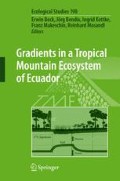Comparative and experimental investigations along the steep altitudinal gradient that is characteristic for Andean ecosystems have formed one of the central paradigms of research at the RBSF in southern Ecuador summarized in the present volume (Lomolino 2001; Rahbek 2005; see Chapter 6 in this volume). For ectothermic insects the increasingly harsher climatic conditions at higher elevations alone impose severe constraints (McCoy 1990; see Chapter 8). Herbivorous insects find fewer plant species and less plant biomass available as nutrient resources at high elevations (see Chapter 10.1). Herbivorous insects are one of the most diverse guilds in terrestrial ecosystems, and within this guild phytophagous beetles and the Lepidoptera (moths and butterflies) are especially species-rich. Available studies on Lepidoptera (the taxonomically best known large insect group) often revealed a mid-elevation bulge of species richness (Holloway and Nielsen 1999; Rahbek 2005). However, many variations occur to this general pattern. For example, on Mt. Kilimanjaro, diversity in the moth family Geometridae is surprisingly low and decreases but slightly throughout the montane forest belt at 2000–3000 m (Axmacher et al. 2004). In the Ecuadorian Andes, in contrast, diversity in the same moth family is exceptionally high and remains almost constant at 1000–2700 m (Brehm et al. 2003b). Yet, these Andean geometrid ensembles (for terminology, see Fauth et al. 1996) change fundamentally with regard to species composition, representation of higher taxa, and body sizes (Brehm and Fiedler 2003, 2004a; Brehm et al. 2003a, b). In this chapter we extend and summarize our investigations of moth diversity in this Andean altitudinal gradient by integrating data on two further, very species-rich moth taxa, viz. Pyraloidea and Arctiidae.
Access this chapter
Tax calculation will be finalised at checkout
Purchases are for personal use only
Preview
Unable to display preview. Download preview PDF.
Author information
Authors and Affiliations
Editor information
Editors and Affiliations
Rights and permissions
Copyright information
© 2008 Springer-Verlag Berlin Heidelberg
About this chapter
Cite this chapter
Fiedler, K., Brehm, G., Hilt, N., Süßenbach, D., Häuser, C.L. (2008). Fauna: Composition and Function. In: Beck, E., Bendix, J., Kottke, I., Makeschin, F., Mosandl, R. (eds) Gradients in a Tropical Mountain Ecosystem of Ecuador. Ecological Studies, vol 198. Springer, Berlin, Heidelberg. https://doi.org/10.1007/978-3-540-73526-7_17
Download citation
DOI: https://doi.org/10.1007/978-3-540-73526-7_17
Publisher Name: Springer, Berlin, Heidelberg
Print ISBN: 978-3-540-73525-0
Online ISBN: 978-3-540-73526-7
eBook Packages: Biomedical and Life SciencesBiomedical and Life Sciences (R0)

